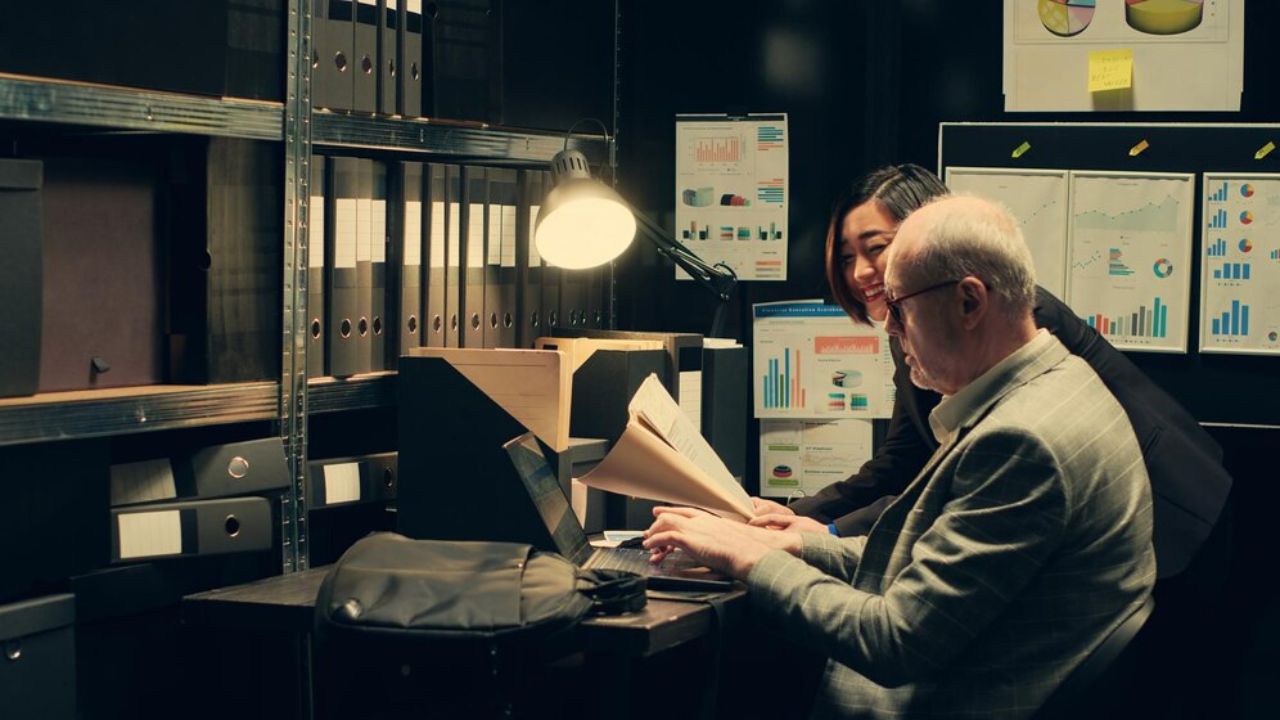BLOG
Jerry Starkes Texas Tech Master Thesis Doc: Key Insights

Jerry Starkes Texas Tech Master Thesis Doc has garnered attention for its comprehensive approach to exploring a significant field of study. While the specifics of Jerry Starkes Texas Tech Master Thesis Doc thesis are unique to its discipline, the methodology, insights, and findings transcend academic barriers, offering valuable lessons for both professionals and students. This blog post provides a closer look at the pivotal aspects of his work, shedding light on why it stands out as a noteworthy contribution.
What You’ll Learn
- An overview of Jerry Starkes’ thesis and its academic importance
- Key methodologies employed in his research
- Major takeaways from the findings
- Lessons for future researchers
Whether you’re a student looking for inspiration for your own thesis or a professional seeking innovative approaches in academic research, Starkes’ work has something for everyone.
The Core of Jerry Starkes’ Thesis
Jerry Starkes Texas Tech Master Thesis Doc focuses on addressing complex challenges through innovative strategies. His research aligns with Texas Tech’s tradition of excellence, integrating both theoretical and practical frameworks to address real-world issues.
Objectives of the Thesis
Starkes’ work sets out to:
- Explore New Perspectives – Introduce fresh viewpoints on longstanding problems within his domain.
- Bridge Theory and Practice – Combine academic theories with actionable solutions.
- Contribute to Academia – Provide insights that add to the body of knowledge in his chosen field.
The scope of his thesis extends beyond academia, making it relevant to professionals and decision-makers. These objectives shape the path and rigor of his research process.
Why It Stands Out
The thesis stands out because of its multidisciplinary approach. Starkes doesn’t confine his research to a single narrow niche; instead, he draws insights from various disciplines, ensuring that his findings have a broader application.
Key Highlights:
- Integration of practical data
- Clear real-world implications
- Focus on solving contemporary challenges
Texas Tech, renowned for fostering academic innovation, provided the ideal environment for Starkes to advance his work.
Research Methodology in Jerry Starkes’ Thesis
A large part of what makes Starkes’ work impactful is his approach to research. He employed a robust and dynamic methodology, ensuring that his findings were both credible and actionable.
1. Literature Review
Starkes began with an extensive review of existing literature to identify gaps in knowledge and establish the context of his study. By evaluating a wide array of sources, he painted a comprehensive picture of the subject while narrowing in on areas for improvement.
2. Data Collection
Using both qualitative and quantitative methods, Starkes ensured his research was backed by concrete evidence.
- Surveys & Interviews: Stakeholder opinions and insights were gathered to add depth to the study.
- Case Studies: Real-world examples formed the backbone of his data analysis.
- Statistical Models: Starkes used validated statistical tools to process and interpret his findings effectively.
3. Multidisciplinary Analysis
One unique aspect of the research was its integration of knowledge from various disciplines. By doing so, he ensured his solutions were both innovative and holistic.
Takeaway for Researchers: Employing multiple methodologies strengthens the validity and depth of your findings.
Key Findings and Takeaways
Starkes’ findings, as detailed in his thesis, contribute valuable insights to the academic and professional community. While the specifics are tied to his subject area, the broader takeaways have universal applications.
Major Insights
- The Role of Innovation: Starkes demonstrated that real breakthroughs come when traditional methods are challenged constructively.
- Importance of Collaboration: His work highlights how cross-disciplinary collaboration can lead to well-rounded solutions.
- Data-Driven Decision Making: The thesis underscores the importance of using reliable data to inform strategic decisions.
Real-World Applications
Starkes’ work isn’t just theoretical. It has serious implications for decision-makers, educators, and specialists in solving challenging practical problems.
Whether you’re in academia, industry, or policy development, these findings emphasize the need for innovative strategies informed by evidence.
Lessons for Future Researchers
Starkes’ thesis serves as a model for how students and professionals can approach complex problems in their research or professional endeavors. Here are a few takeaways for those looking to produce impactful work:
1. Define Clear Objectives
Success in academic research begins with well-defined objectives. Keep your key focus areas manageable and impactful to avoid overextending your scope.
2. Be Multidisciplinary
If there’s one standout feature of Starkes’ work, it’s his reliance on insights from multiple fields. This integrated approach allowed him to develop well-rounded solutions.
3. Leverage Data Wisely
Using both qualitative and quantitative data offers a well-balanced perspective. Starkes illustrated this perfectly, reinforcing the importance of validating theoretical assumptions with data.
4. Engage Your Audience
Whether it’s thesis advisors, your academic committee, or future professional readers, your research needs to engage. Starkes’ choice of topic and practical implications made his thesis relevant and compelling.
5. Refine Regularly
Starkes ensured every detail of his thesis was polished before submission. Frequent revisions help clarify arguments, address potential weaknesses, and improve overall readability.
By following these steps, future researchers can maximize the impact of their academic endeavors.
Bringing It All Together
Jerry Starkes’ Texas Tech Master Thesis stands as an example of academic excellence, innovation, and real-world relevance. By combining multidisciplinary approaches, rigorous methodology, and actionable insights, he has created a piece of work that inspires and educates in equal measure.
Whether you’re a student preparing your thesis or an industry professional seeking smarter strategies for problem-solving, there’s plenty to learn from Starkes’ process and findings. Take a page from his playbook and focus on innovation, evidence, and relevance to make your work stand apart.
Want more insights or help crafting impactful research? Stay inspired with our expert guides and resources tailored for academic and professional growth!
BLOG
The Art and Precision of Modern Metal Cutting Techniques

Metal cutting is a crucial procedure in numerous sectors, allowing for the transformation of raw metals into precise shapes and sizes required for specific applications. The significance of precision metal cutting cannot be overstated, as it contributes significantly to advancements in manufacturing and engineering. Metal cutting techniques have evolved to support the creation of components integral to modern engineering projects, from intricate parts requiring extraordinary precision to robust components designed to withstand severe conditions. This article delves into the evolution, techniques, and future trends of metal cutting, a crucial aspect of modern industrial processes, offering insight into how these sophisticated techniques are shaping the world around us.
Introduction to Metal Cutting
At the core of manufacturing is metal cutting, a process that not only turns raw materials into essential components but also influences the quality and performance of the final product. Without accurate metal cutting, industries would struggle to satisfy the strict demands of contemporary machinery and infrastructure. This procedure is fundamental in manufacturing, allowing engineers and designers to expand the limits of functionality and aesthetics across a range of products, from everyday household items to advanced aerospace innovations. As such, understanding metal cutting involves being familiar with the techniques and appreciating their broader impact on technology and innovation.
The Evolution of Metal Cutting Technology
Metal cutting technology has transformed remarkably from the early days of hammers and chisels to today’s high-tech laser cutters—initially, manual tools required skilled labor and significant time investments for detailed cuts. However, the invention of power tools brought more speed but with limited precision. The transformative advent of CNC machines marked a significant milestone, introducing computerized controls that allowed for unparalleled accuracy and consistency in production processes. This shift improved efficiency and opened new possibilities for complex geometries previously impossible to achieve with manual methods. In recent years, technological advancements such as laser cutting have enabled the handling of ultra-fine materials with minimal waste and maximum accuracy.
Common Metal Cutting Techniques
The array of metal cutting techniques available today, including laser, plasma, and waterjet cutting, offers an extensive toolkit for manufacturers and engineers. Laser cutting, renowned for its precision, uses focused light to slice through materials with exceptional accuracy and detail, making it ideal for small parts with intricate designs. Plasma cutting, using electrically conductive gas, provides a high-speed option suited for thicker materials, thus balancing cost with performance. Waterjet cutting stands out because it employs a high-pressure stream of water, often mixed with abrasives, to cut through virtually any material without introducing heat, thus preventing material warping.
Industries Relying on Metal Cutting
Metal cutting is indispensable in industries such as automotive and aerospace. From crafting the body of a vehicle to developing detailed turbine blades, the demand for flawless execution relies heavily on advanced metal cutting. In these sectors, recent updates in metal fabrication techniques are critical to enhancing the efficiency and functionality of parts. In construction and infrastructure, metal cutting is essential in creating the structural components that form the backbone of modern society, underscoring its universal application across various essential sectors.
Innovative Tools in Metal Cutting
Modern metal cutting tools have seen significant advancements to meet the needs of industry professionals who demand more from their equipment. Innovations like smart tools with IoT capabilities allow for real-time monitoring and adjustments, increasing safety and efficiency. These tools, often integrated with AI-driven systems, can learn and adapt to intricate tasks, minimizing errors and enhancing productivity. Advances in materials, such as diamond-edged cutting tools, contribute to longer tool life and cleaner cuts, which are crucial in high-precision environments like electronics and medical devices.
Safety and Environmental Considerations
Safety remains a top priority in metal-cutting environments due to potential hazards such as flying debris, harmful noise levels, and intense light emissions. Adhering to safety protocols, such as wearing personal protective equipment (PPE) and properly maintaining machinery, significantly reduces these risks. Environmental considerations are equally vital, with an increasing focus on reducing waste and energy consumption. Implementing sustainable practices underscores the growing commitment across industries to ecological responsibility.
Future Trends in Metal Cutting
As we look ahead, the field of metal cutting is set for thrilling advancements propelled by technological progress and growing environmental awareness. Techniques such as hybrid cutting systems, which combine different methods for optimal results, are on the rise. At the forefront of these advancements is the integration of AI, which promises enhanced predictive maintenance and operational efficiency. Moreover, sustainable cutting solutions, aided by eco-friendly technologies and materials, are transforming the industry to be more compliant with global green standards. Staying abreast of engineering innovations and enhancing productivity will be key to maintaining competitive advantage as the industry evolves.
Conclusion
In conclusion, metal cutting is a vital process that is continuously advancing in its techniques and applications, shaping the fabric of modern industry. Its evolution from manual to high-tech methods underscores the dynamic nature of technological progression in meeting ever-increasing demands for precision and efficiency. As we navigate future challenges and innovations, the emphasis on sustainable practices and cutting-edge technology will define the trajectory of this essential industrial process, ensuring that metal cutting remains at the forefront of manufacturing and design innovation for years to come.
BLOG
Transform Your Bathroom: Creative Remodeling Ideas to Enhance Functionality and Style

Introduction to Bathroom Remodeling
Revamping your bathroom isn’t just about creating a luxurious retreat; it can also significantly boost your property’s value. With home renovation trends rising, embracing innovative ideas in bathroom remodeling can turn your personal space into a serene sanctuary. For those seeking inspiring transformations, explore diverse projects at https://aldrichcontracting.com/our-work/bathroom-remodeling/ that illustrate the art of blending functionality with aesthetics. A well-executed remodel doesn’t merely refresh the visual appeal but enhances everyday usability, making your bathroom a place of relaxation and renewal.
Homeowners increasingly recognize the bathroom as a pivotal space deserving of special attention. Often seen merely as a utilitarian space in years past, the modern bathroom now serves as a refuge from the busyness of daily life. From contemporary fixtures to sustainable materials, the scope for creativity is vast. Dive into these remodeling ideas that promise to elevate your bathroom’s style and efficiency, creating a place of comfort and an expression of personal style.
Benefits of a Bathroom Makeover
Upgrading your bathroom is a savvy investment yielding aesthetic enhancement and increased property value. A remodeled bathroom captivates potential buyers and adds to the appeal of your home. According to the Cost vs. Value Report, bathroom renovations often result in substantial returns during a home’s resale. From modern fixtures to innovative design elements, a well-executed bathroom upgrade can transform your space into a sophisticated sanctuary, supporting style and function. The addition of spa-like amenities—rain showers, soaking tubs, and radiant floor heating—turns everyday routines into moments of luxury, thus providing long-term satisfaction and enhancing the property’s appeal.
Popular Styles for Modern Bathrooms
Regarding style, bathrooms offer a canvas for creativity and personal expression. Contemporary trends favor minimalist designs, vintage flair, and industrial chic aesthetics. By focusing on sleek lines, neutral palettes, and non-cluttered decor, minimalist designs impart a sense of calm and increase the room’s elegance. Meanwhile, vintage elements such as claw-foot tubs, antique fixtures, and retro tiles introduce nostalgia and charm, making the space unique and inviting. The industrial chic style combines raw materials like exposed brick and metal accents, bringing an edgy vibe and practical durability. Whether opting for modern minimalism or bold vintage touches, the right blend of style and personal taste can create a functional and luxurious bathroom.
Enhancing Space Efficiency and Functionality
Efficient design is key to a successful bathroom remodel, especially in smaller spaces. Creative storage solutions like floating shelves, hidden cabinets, and recessed niches can increase storage without consuming floor space. To enhance usability, choosing fixtures that fit the bathroom’s dimensions and meet its users’ daily needs is essential. Consider dual-function installations like a vanity with under-sink storage or a mirror with integrated lighting. Thoughtful design maximizes space and elevates functionality, ensuring that even the smallest bathrooms feel expansive and practical. By choosing innovative layout designs, homeowners can balance style and efficiency, maximizing every inch of their remodeled space.
The Role of Eco-Friendly Materials
Embracing sustainable materials in your bathroom remodel is a win for the environment and your home’s aesthetic appeal. Opt for low-flow toilets and faucets, significantly reducing water consumption while maintaining performance. Eco-friendly tiles from recycled glass or porcelain offer style and sustainability, aligning good design with ecological responsibility. Exploring the full potential of sustainable options is transformative. By choosing green alternatives such as bamboo flooring, VOC-free paints, and recycled fixtures, homeowners contribute to a healthier planet while enjoying the long-lasting benefits of quality materials.
Budgeting for a Bathroom Remodel
Planning a bathroom remodel necessitates a clear strategy to adhere to your financial limitations while maximizing the results. It’s essential to identify project aspects where splurging is advantageous—such as investing in high-quality countertops, shower systems, or custom cabinetry—and where cost-effective solutions can be applied, like selecting budget-friendly lighting or tiling. Careful planning makes achieving a balanced approach that fulfills aesthetic desires and practical needs possible without financial strain. Engaging with professionals for a detailed scope of work ensures transparency. It allows homeowners to adjust their expectations and budgets accordingly, resulting in a reliably managed project from start to finish.
Conclusion: Tips for a Successful Renovation
Transforming your bathroom can be a rewarding endeavor that combines creativity with practicality. Remember to tailor your design to reflect your style, embrace efficiency, and practice sustainable living. From sleek modern designs to quiet vintage charm, the possibilities are endless. By balancing indulgence with innovation, your new bathroom can become a luxurious retreat that adds significant value and comfort to your home. Whether through minor tweaks or a full-scale makeover, successful renovations hinge on thoughtful planning and execution, ensuring lasting satisfaction and aesthetic appeal.
BLOG
How Botox Works: Understanding the Science Behind Smoother Skin

Botox is a popular cosmetic procedure known for smoothing wrinkles and fine lines. It works by temporarily paralyzing specific facial muscles. Understanding the science behind Botox can help individuals make informed choices about its use.
Introduction
Botox is one of the most well-known cosmetic procedures. Widely used to reduce the appearance of wrinkles, many people seek Botox treatments for their proven effectiveness and minimal recovery time. But what about Botox? What makes it so successful in achieving smoother skin?
Exploring Botox’s scientific basis is essential to understanding its impact. This article delves into the biological mechanisms that underpin Botox treatments, elucidating how this substance achieves its desirable effects. This exploration is timely and invaluable for individuals contemplating Botox or those interested in the biochemistry behind smoother, more youthful skin.
The Mechanism of Botox
Botox, medically known as botulinum toxin, is derived from a bacterium called Clostridium botulinum. While it originated from a toxin, researchers have harnessed its properties to safely and effectively address cosmetic concerns. Botox targets the nervous system; more specifically, it blocks the release of acetylcholine, a neurotransmitter responsible for muscle contraction.
When a small, controlled dose of Botox is injected into specific facial muscles, it inhibits the nerve signals that trigger muscle contractions. This temporary paralysis relaxes wrinkles and fine lines, resulting in a smoother appearance. Botox can be employed in various settings, such as Salt Lake City, where skilled botox in Salt Lake City provides tailored treatments for a diverse clientele.
How Botox is Applied
The application of Botox is a precise process that requires a trained healthcare professional to ensure safety and desired outcomes. The journey begins with a comprehensive consultation, during which the patient’s goals and medical history are assessed. Understanding the facial anatomy is crucial, as it allows the practitioner to identify target areas for injection.
Once the target muscles are identified, the practitioner uses fine needles to inject the Botox directly into these areas. This minimally invasive procedure usually takes less than 30 minutes, allowing patients to resume their daily activities immediately. Knowing the optimal dosage and injection technique is key to preventing over or under-treatment.
Effects on Muscles and Skin
The effects of Botox are both direct and indirect. Botox provides immediate relief from expression lines by acting on muscle contractions, particularly the dynamic wrinkles that form with facial movements. Over time, the skin above these relaxed muscles starts to smooth out as constant tension is relieved, allowing the skin to recover.
In addition to cosmetic improvements, Botox has been used for medical purposes, such as treating migraines and excessive sweating. Skin starts to feel more supple and youthful, and these aesthetic changes often boost self-confidence, reflecting a positive psychological impact.
Duration and Maintenance
The effects of Botox are not permanent, which means recurring treatments are necessary to maintain results. Typically, the smoothing effects can be seen within a few days post-injection, with full results visible by the two-week mark. On average, the effects of a Botox treatment last between three to six months.
Individuals often schedule follow-up appointments for ongoing smoothness to ensure minimal lapse in muscle relaxation. With regular treatments, some find they can extend the time between sessions as their muscles gradually adapt to reduced activity. Each session should be tailored to the patient to prevent muscle atrophy or other adverse effects.
Safety and Efficacy
Botox is well-regarded for its safety when administered by a trained and experienced professional. While potential side effects like bruising or minor swelling can occur, serious complications are rare. Following post-treatment guidelines, such as avoiding strenuous activities and keeping the head upright, can mitigate risks.
Its efficacy is backed by numerous clinical studies and satisfied patients who continue to choose Botox for their aesthetic goals. The assurance of predictable outcomes makes Botox a staple in cosmetic dermatology. Nevertheless, candid conversations with healthcare providers ensure patients have realistic expectations and understand the procedure’s limitations and benefits.
Conclusion
Botox remains a cornerstone in contemporary cosmetic medicine, providing individuals with the means to achieve smoother, more vibrant-looking skin. Understanding the science behind Botox allows for informed decisions, empowering those considering this treatment to pursue it confidently.
By working with qualified professionals and clearly understanding its mechanism and effects, Botox can seamlessly fit into a skincare regimen, offering aesthetic and psychological benefits. As research continues to refine its use, Botox will likely remain at the forefront of beauty innovations, demonstrating its enduring value.
-

 BLOG11 months ago
BLOG11 months agoBebasIndo: Transforming Service Accessibility Across Indonesia
-

 TECH12 months ago
TECH12 months agoLepbound: Unlocking the Hidden Power of Optimization in Science and Technology
-

 ENTERTAINMENT12 months ago
ENTERTAINMENT12 months agoDiamond Pink: A Rare Gem, A Precious Possession
-

 BUSINESS11 months ago
BUSINESS11 months agoChannelsyncharma: Your Guide to Effective Channel Management
-

 BUSINESS11 months ago
BUSINESS11 months agoQuick Relief with Immediate 0.3 Folex
-

 TECH12 months ago
TECH12 months agoGirma Zekpa: An Influential Figure in Business and Technology
-

 NEWS11 months ago
NEWS11 months agoSo Ji-Sub LPSG: From Model to Star, the Evolution of a Korean Icon
-

 HEALTH11 months ago
HEALTH11 months agoCarson Dennis Dentist Orthodontics Navy HPSP: A Comprehensive Guide
